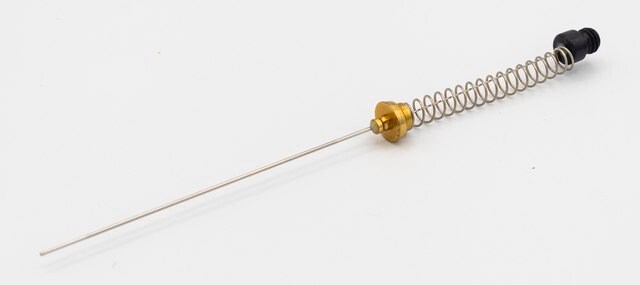57439-U
SPME Fiber Assembly
PDMS/DVB, Overcoated, for use with autosampler or manual holder, Nitinol-core (NIT), 23 ga, 75 μm (Coating thickness includes 65 μm + 10 μm OC (overcoating))
Synonym(s):
SPME-Overcoated Fiber Polydimethylsiloxane/Divinylbenzene (PDMS/DVB)
About This Item
Recommended Products
product name
SPME-OC Fiber Assembly, Polydimethylsiloxane/Divinylbenzene (PDMS/DVB), df 75 μm(Coating thickness includes 65 μm coating + 10 μm OC (overcoating), needle size 23 ga, pkg of 3 ea, fiber L 1 cm
material
StableFlex fiber (Polydimethylsiloxane/Divinylbenzene (PDMS/DVB))
notched pink hub
Quality Level
needle size
23 ga
description
Polydimethylsiloxane/Divinylbenzene (PDMS/DVB) fiber overcoated with a layer of PDMS.
packaging
pkg of 3 ea
greener alternative product characteristics
Waste Prevention
Safer Solvents and Auxiliaries
Learn more about the Principles of Green Chemistry.
sustainability
Greener Alternative Product
df
75 μm (Coating thickness includes 65 μm coating + 10 μm OC (overcoating))
technique(s)
solid phase microextraction (SPME): suitable
fiber L
1 cm
matrix active group
PDMS/DVB coating, Overcoated Polydimethylsiloxane/Divinylbenzene
application(s)
food and beverages
compatibility
for use with autosampler or manual
greener alternative category
General description
Application
- A solid phase microextraction Arrow with zirconium metal-organic framework/molybdenum disulfide coating coupled with gas chromatography-mass spectrometer for the determination of polycyclic aromatic hydrocarbons in fish samples: This study highlights the effectiveness of PDMS/DVB SPME fibers in detecting polycyclic aromatic hydrocarbons in fish, showcasing their potential in environmental and food safety applications (Yuan Y, Lin X, Li T, 2019).
- Applicability of the new 60 μm polyethylene glycol solid-phase microextraction fiber assembly for the simultaneous analysis of six pesticides in water: This research illustrates the use of SPME fibers for the efficient and simultaneous analysis of multiple pesticides in water samples, underscoring their value in environmental monitoring and chemical analysis (Pereira A, Silva E, Cerejeira MJ, 2014).
- Passive sampling of ambient ozone by solid phase microextraction with on-fiber derivatization: This study demonstrates the utility of SPME fibers for passive air sampling and analysis of ozone, providing a valuable tool for environmental monitoring and analysis of atmospheric compounds (Lee IS, Tsai SW, 2008).
- Diffusive sampling of airborne furfural by solid-phase microextraction device with on-fiber derivatization: This publication showcases the application of SPME fibers for capturing and analyzing airborne furfural, highlighting their use in air quality monitoring and industrial environments (Tsai SW, Kao KY, 2006).
Choose from one of the most recent versions:
Certificates of Analysis (COA)
Sorry, we don't have COAs for this product available online at this time.
If you need assistance, please contact Customer Support.
Already Own This Product?
Find documentation for the products that you have recently purchased in the Document Library.
Customers Also Viewed
Articles
A direct immersion SPME method using a new overcoated SPME fiber was developed for the extraction of pesticides from pureed prune baby food.
Pesticide analysis, SPME Fiber, supelco spme fiber, direct immersion spme, pesticide analysis methods, pesticide analysis by gc-ms, DI-SPME, overcoated SPME, overcoated fibers, soy milk analysis
Protocols
Bisphenol A (BPA) is suspected to be an endocrine disruptor. Regulations on specific migration limits (SML) from food contact materials are getting tighter (EU 2018/213) requiring more sensitive determinations. An overcoated SPME fiber provides the durability necessary for direct immersion into foods such as canned soup and pumpkin, allowing for low level analysis of BPA via SPME-GC-MS/MS.
Related Content
GC/MS/MS Analysis of Bisphenol A (BPA) in a Fruit Flavored Energy Drink on the SLB-PAHms Column After SPME Using an Overcoated SPME Fiber
Solid phase microextraction (SPME) is a solvent-free sample preparation technique that uses coated fibers to extract analytes of interest from a sample before analysis by GC or HPLC.
Our team of scientists has experience in all areas of research including Life Science, Material Science, Chemical Synthesis, Chromatography, Analytical and many others.
Contact Technical Service








